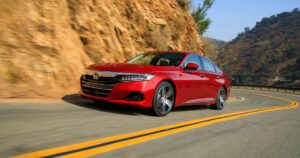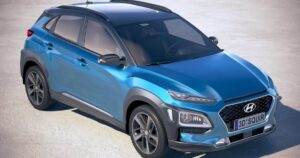A mild hybrid car is an innovative vehicle that blends traditional internal combustion engines with mild electric assistance. It offers a middle ground between conventional gasoline or diesel-powered cars and full hybrids.
The design focuses on enhancing fuel efficiency and reducing emissions, making it a preferred choice for eco-conscious drivers. This technology is particularly beneficial in stop-and-go traffic, where the electric motor assists the engine, reducing fuel consumption.
The system in mild hybrid cars is simpler and more affordable compared to full hybrid or electric vehicles. The electric motor in these vehicles cannot power the car on its own but provides a boost during acceleration and supports functions such as engine start-stop.
How Does A Mild Hybrid Car Work?
A mild hybrid car operates with the help of an internal combustion engine, an electric motor, and a small battery pack. The system works by recovering energy that is normally lost during braking or deceleration. This energy is stored in the battery and used to assist the engine when needed.
- The energy recovery system ensures minimal energy wastage.
- The electric motor supports the start-stop system, improving efficiency.
- The smaller battery size reduces the car’s overall weight.
These cars do not require external charging because the battery recharges itself during normal driving. This makes mild hybrids convenient for drivers who do not have access to charging stations.
Benefits Of Owning A Mild Hybrid Car

Mild hybrid cars offer several advantages that appeal to a wide range of consumers. These benefits include improved fuel efficiency, lower emissions, and enhanced driving performance. This leads to reduced operating costs over time.
With reduced emissions, mild hybrids contribute to cleaner air and help combat climate change. Drivers can enjoy these benefits without significantly altering their driving habits or dealing with the range anxiety often associated with electric cars.
Additionally, mild hybrids are often more affordable than full hybrids or electric vehicles. They strike a balance between cost, performance, and environmental benefits, making them an attractive option for budget-conscious buyers.
Components Of A Mild Hybrid System
A mild hybrid car consists of several key components that work together seamlessly:
- Internal Combustion Engine: The primary power source for the vehicle.
- Electric Motor: Assists the engine during acceleration and other high-load conditions.
- Battery Pack: Stores energy recovered during braking and deceleration.
- Energy Recovery System: Captures and converts kinetic energy into electrical energy.
- Control System: Manages the interaction between the engine and the electric motor.
Each component is designed to maximize efficiency and minimize emissions. The system’s simplicity ensures durability and lower maintenance costs compared to more complex hybrid or electric vehicles.
Mild Hybrid vs. Full Hybrid Differences
Mild hybrid and full hybrid vehicles share similarities but also have distinct differences. While both use electric motors to enhance efficiency, their functionalities and capabilities vary significantly.
- Electric-Only Mode: Full hybrids can operate solely on electric power, while mild hybrids cannot.
- Battery Size: Full hybrids feature larger batteries capable of powering the car, unlike the smaller batteries in mild hybrids.
- Cost: Mild hybrids are generally less expensive than full hybrids due to simpler technology.
- Energy Usage: Mild hybrids rely on electric assistance, whereas full hybrids offer full electric propulsion for short distances.
Understanding these differences helps consumers choose the right type of hybrid vehicle based on their preferences and budget.
Environmental impact Of Mild Hybrid Cars
Mild hybrid cars contribute positively to the environment by reducing greenhouse gas emissions. The electric motor’s assistance reduces fuel consumption, leading to fewer emissions. This is particularly important in urban areas with high traffic density, where cars spend considerable time idling or in slow-moving traffic.
Governments and environmental organizations recognize the role of mild hybrids in achieving climate goals. Some regions even offer incentives to promote the adoption of such vehicles. By choosing a mild hybrid, drivers contribute to a sustainable future while enjoying modern automotive technology.
Cost Efficiency Of Mild Hybrid Cars
One of the most attractive aspects of mild hybrid cars is their cost efficiency. These vehicles typically cost less than full hybrids or electric cars, making them accessible to a broader audience. The reduced fuel consumption translates to lower running costs over the vehicle’s lifespan.
Moreover, mild hybrids often come with lower maintenance costs. The simpler design reduces the likelihood of expensive repairs. Combined with their fuel efficiency, these factors make mild hybrids a financially sensible choice for many buyers.
Fuel Economy in Mild Hybrid Cars

Fuel economy is a standout feature of mild hybrid cars. The electric motor’s assistance reduces the strain on the engine, especially during fuel-intensive operations like acceleration and climbing. This results in better mileage compared to conventional vehicles.
Many manufacturers highlight the impressive fuel economy of their mild hybrid models, making them an attractive option for drivers looking to save money at the pump. The combination of improved mileage and reduced emissions is a win-win for both the driver and the environment.
Driving Experience in Mild Hybrid Cars
The driving experience in a mild hybrid car is smooth and responsive. The electric motor provides instant torque, enhancing acceleration and overall performance. Drivers often notice improved responsiveness compared to traditional vehicles.
The start-stop system is another feature that enhances the driving experience. It automatically shuts off the engine when the car is idling and restarts it seamlessly when needed. This not only improves fuel efficiency but also contributes to a quieter and more comfortable ride.
Availability Of Mild Hybrid Models
Mild hybrid technology is becoming increasingly common, with many automakers offering a range of models. From compact sedans to SUVs, consumers have various options to choose from. Leading manufacturers like Toyota, Honda, and Ford have introduced mild hybrid versions of their popular models.
The availability of mild hybrids continues to grow as more companies invest in this technology. Consumers can expect even more options in the future as the demand for eco-friendly vehicles increases.
Future Of Mild Hybrid Cars
The future of mild hybrid cars looks promising as automotive manufacturers prioritize sustainability and innovation. With advancements in battery technology and energy recovery systems, mild hybrids are expected to become even more efficient.
Governments worldwide are implementing stricter emission regulations, pushing automakers to adopt cleaner technologies. Mild hybrids will likely play a crucial role in bridging the gap between traditional vehicles and fully electric cars.
Challenges Of Mild Hybrid Technology
Despite their benefits, mild hybrids face certain challenges. One limitation is their inability to operate solely on electric power, which may deter some eco-conscious buyers. Additionally, the smaller battery size means they do not offer the same level of energy storage as full hybrids or electric vehicles.
Another challenge is consumer awareness. Many drivers are unfamiliar with the benefits of mild hybrids, which can impact adoption rates. Manufacturers and dealers need to educate potential buyers about the advantages of this technology.
Mild Hybrid Cars And Urban Driving
Mild hybrid cars excel in urban driving conditions. The frequent start-stop traffic in cities allows the energy recovery system to function optimally, maximizing efficiency. The electric motor’s assistance reduces fuel consumption during acceleration, making city commutes more economical.
Urban drivers also benefit from the quieter operation of mild hybrids, enhancing comfort during daily commutes. These features make mild hybrids an ideal choice for city dwellers.
Consumer Perception Of Mild Hybrid Cars
Consumer perception of mild hybrid cars is generally positive, especially among those seeking a balance between performance and environmental responsibility.
- Drivers appreciate the improved fuel efficiency and reduced emissions without sacrificing driving pleasure.
- However, some consumers may hesitate to adopt mild hybrids due to misconceptions or lack of information.
- Unlike fully electric or plug-in hybrids, mild hybrids rely on a smaller electric motor and battery that work in conjunction with the primary engine.
Clear communication about the benefits and functionalities of mild hybrids is essential to increase adoption rates.
Mild Hybrids in The Global Market

Mild hybrid cars are gaining popularity in global markets. Regions with stringent emission regulations, such as Europe, have seen significant growth in mild hybrid adoption. The technology is also appealing in markets where fuel prices are high, as it offers a cost-effective alternative.
Automakers are expanding their mild hybrid offerings to cater to diverse consumer needs. As the demand for eco-friendly vehicles continues to rise, mild hybrids are expected to play a significant role in the global automotive landscape.
Tips For Mild Hybrid Cars
- Combines internal combustion engine with electric assistance.
- Reduces fuel consumption and emissions.
- Does not require external charging.
- Offers improved performance and efficiency.
- More affordable than full hybrids or electric vehicles.
Frequently Asked Questions
Do mild hybrid cars need charging?
No, mild hybrid cars do not require external charging. The battery recharges itself during braking and deceleration.
Are mild hybrid cars better for the environment?
Yes, mild hybrid cars produce fewer emissions compared to conventional vehicles, making them more environmentally friendly.
How much fuel can a mild hybrid save?
Mild hybrid cars can save 10-20% more fuel compared to traditional internal combustion vehicles, depending on driving conditions.
Are mild hybrids expensive to maintain?
No, mild hybrids are generally affordable to maintain due to their simpler design and durable components.
Conclusion
Mild hybrid cars represent an innovative step in automotive technology. By combining traditional engines with electric assistance, they offer improved fuel efficiency and an enhanced driving experience. These vehicles bridge the gap between conventional cars and fully electric models, making eco-friendly transportation accessible to more consumers.

Hello, Ride here I’m excited to share everything about hybrid cars. We provide helpful Tips And guide about hybrid cars.











